- Home
- Keith R. A. DeCandido
Star Trek: TNG: Enterprises of Great Pitch and Moment Page 5
Star Trek: TNG: Enterprises of Great Pitch and Moment Read online
Page 5
Picard smiled. “What rule did you break?”
“O’Brien was trying to contact the Rio Grande—we thought it was still in orbit. But I’m the chief’s CO, so I was the one punished.”
“Where was the runabout?”
“Alixus, the woman who ran the colony, she set it off into the sun—or so she thought. Her aim was off, and it deflected off the sun’s corona.” Although he wasn’t facing the other man, Picard could hear the smile in Sisko’s voice when he said, “I told you the Rio Grande was blessed.”
“Indeed.”
They trudged onward in silence for a bit, then Picard said, “Before the plasma storm hit, Gowron’s pod armed weapons.”
“So you said. You think he planned to fire on us?”
“Weapons are of little use against a plasma storm. If he’d just raised shields, I’d understand, but I think that, if we do find survivors, we have to assume they’re hostile.”
“I agree. I don’t like it much, but I agree.” He paused.
“You were Gowron’s Arbiter of Succession, right?”
“Technically, I was K’mpec’s. My task as Arbiter was to determine the final two candidates, who would then battle to see who would be chancellor. However, there were only two candidates—Gowron and Duras. K’mpec’s true purpose in giving me the task was to find out who poisoned him.”
“Poison? That’s not very Klingon, is it?”
“No—which is why K’mpec tasked me with finding his murderer. We never did determine who it was, though the evidence pointed to Duras. You may believe me, Ben, that as difficult as Gowron has been, Duras would have been several orders of magnitude worse.”
As he spoke, Picard came around a large rock and discovered that the path had finally taken them to a part of the mountain that inclined downward—he could see a valley in front of them. A trail of smoke was rising from the valley, and Picard immediately took out his tricorder.
Sisko moved to stand next to him, close enough that Picard no longer needed the combadge to hear him. “Is that what I think it is?”
“Uh-huh.” Picard nodded. “The shuttlepod.”
The two captains moved faster, in part due to now moving downhill, but mainly because their goal was in sight. Sisko had his phaser rifle out, and after a moment, Picard realized he should do likewise. It galled him to go into a situation with weapons raised. Pulling a weapon should be a last resort, not a first one, but he himself had pointed out that Gowron was about to fire on them when the plasma storm hit. It was better, under these circumstances, to be safe—especially when dealing with Klingon warriors, for whom weaponry was often the first resort among friends, much less enemies.
Sisko and Picard walked abreast now, and Picard voiced his concerns. “There was a time when we would not have been approaching a downed Klingon shuttlepod with phasers at the ready.”
“There was a time,” Sisko said, “when there weren’t Founders lurking behind every tree and when the Klingons and the Federation were allies. Times, unfortunately, change.”
“Our duty is to try to change it back,” Picard said.
“Can’t argue with that,” Sisko said. “It’s why we’re here.”
As they grew closer to the pod, it became increasingly clear that they were not going to meet any resistance. No one fired upon them, no one greeted them, nothing. Picard wasn’t sure if that was a good thing or not.
The pod had landed nose-down in the snow, very similarly to the way the Zambesi had. A snowdrift had built up on the port side, which was another piece of evidence to support the notion that, if there were survivors, they were not in any shape to fight.
Which was good, as Picard was ready to collapse. The adrenaline surge he’d gotten upon sighting the pod burned itself completely out by the time they reached it. Every movement caused what felt like daggers through his back.
Next to him, Sisko peered at his tricorder. “The distress beacon is about the only thing still working on that ship. Propulsion’s down, life support failing, hull integrity at only twenty-five percent.” He smiled. “Tactical systems are intact, though.”
“Klingon engineers, in my experience, build such to last.”
“Lucky us.” He shook his head. “I’m not picking up any life signs.”
Picard moved gingerly toward the pod’s rear hatch, the only one of its two entrances available to them—the side door was currently buried in snow. “I shudder to think about what it would mean for the chances of peace between the empire and the Federation if the Klingon chancellor died ignominiously in a shuttlepod crash in the Badlands while meeting with two Starfleet captains.”
“My money would be on it not meaning much for those chances,” Sisko said grimly.
“Agreed.” When they reached the hatch, Picard shrugged out of his backpack and rummaged through it for a P-38. Engineers referred to P-38s as “can openers”—the devices loosened connections that kept doors shut, particularly when jammed or depowered. Picard just hoped that it would be as effective on Klingon hatches as it tended to be on Starfleet ones.
Looking over at Sisko, the younger man held his phaser rifle ready and nodded.
Nodding back, Picard applied the P-38. A pneumatic hiss followed a moment later, and then the hatch rolled aside with a grinding rumble that cut through the howling of the wind.
The air inside was just as cool as the air outside, confirming that life support had indeed failed. Right now, the pod’s twenty-five-percent–integrated hull was the only thing keeping the cold out.
Klingons, he knew, were more vulnerable than humans to cold. It was the only way the average Klingon could be considered physically weaker than the average human. Picard added that to the overwhelming evidence that said that Gowron and his compatriot were dead.
It was dark inside, with the only illumination coming from a few red lights on one of the consoles and, now, the open hatch. Picard activated the light atop his phaser rifle, and Sisko did likewise.
At once, Picard realized that they were both right and wrong. There were no survivors on the pod, but Gowron still lived.
Because the two dead bodies lying on the pod’s deck were not the two people who’d contacted the Zambesi from orbit.
Shining his phaser’s light on the belt of one of the bodies, Picard said, “A qutluch.”
“Gesundheit.”
Picard couldn’t help but smile. “That’s the weapon of an assassin. Remember when I said that Duras would be a worse chancellor than Gowron? I formed that opinion, in part, because he sent two men very much like this after me on Qo’noS seven years ago. I was almost on the receiving end of one of those blades.”
“So it looks like we were right, and Azernal’s dismissal was premature,” Sisko said. “Somebody wanted the two of us to think Gowron was meeting us, so they could kill us. The question is, was it Gowron or one of his enemies?”
“Or one of his friends trying to help him.” Picard shook his head. “That question should, I think, be tabled. A rescue party being sent after this ship may not have our best interests at heart.”
The comm line then crackled, and a voice spoke in the Klingon language amid tremendous static. “Gyrik, this is Ngabwi. Res…re the humans dea…spond! We wi…the Badlands within the hour. Ngabwi out.”
Picard looked at Sisko, who said, “Definitely not our best interests at heart.”
CHAPTER
9
U.S.S. Enterprise-E
En route to the Badlands
Sean Hawk tried to coax some more speed out of the Enterprise engines.
It had been an interesting year on the new flagship. Hawk had been a “plank owner” of the Enterprise-E, having served aboard since its space frame was first constructed. He’d worked with dozens of engineers, including the legendary Montgomery Scott, on the Sovereign-class vessel’s design. He knew the ship as well as or better than anyone.
And he knew he could get more speed out of her.
His time aboard ship had not bee
n dull. Linda Addison, one of his oldest friends, who was to have been security chief, had been killed and replaced with a changeling who almost destroyed the ship. He’d been targeted by a shadowy organization within the Federation.
And he’d found true love.
That last part had been particularly gratifying. He hadn’t really been looking when he met Ranul Keru, an unjoined Trill serving in stellar cartography, but it had also been his experience through a lot of busted relationships that the ones you weren’t looking for were the ones that lasted.
The two of them had seen Arms and the Man together last night, and Keru had conned Hawk into trying out for Dr. Crusher’s next production, whatever it might be. Keru already intended to, and after a great deal of badgering over a late, after-performance dinner in Ten-Forward, he’d agreed.
Hawk had never stood on a stage in his life. He was a pilot and engineer—the type of person who worked behind the scenes. Maybe I can convince the doc to put me on the tech crew.
His thoughts were interrupted by a call from engineering. “Porter to Hawk.”
“Go ahead.”
“You should be able to get warp nine-point-eight out of her now, Sean.”
Hawk smiled. “Thanks, Paul.” He turned to Data. “Sir, we’re now at warp nine-point-six and rising.”
“Thank you, Mr. Hawk,” Data said from the command chair.
Next to him at the operations console, Lieutenant Miranda Kadohata picked something up. Kadohata, a raven-haired woman who had served in the sensor room on the Enterprise-D, Hawk knew, was filling in at ops while Data was acting as first officer in Riker’s absence. “Sir, we’re picking up the bird-of-prey—it’s on course for the Badlands.” She spoke with a British accent, though she hailed from the Cestus III colony. Hawk had been meaning to ask her how that happened, exactly.
“Identify the ship, please,” Data said.
Kadohata shook her head. “We’re still too far to get an ID, but it’s definitely Bre’el-class, and its course will take it straight to B’Leva.” A moment later: “Sir, we’re now picking up a distress signal. It’s an automated Klingon Defense Force call.”
Data got to his feet and moved to stand between Kadohata and Hawk. “Can you identify the source of the distress call, Lieutenant?”
“I think so.” Kadohata ran her lithe fingers over her console. “It registers as belonging to a Defense Force shuttlepod—Kivra-class.” She turned around to look at Data. “Commander, according to the Defiant’s probe, the pod that was meeting the captain was Kivra-class.”
“If they are sending a distress signal, that would indicate a difficulty that Captain Picard and Captain Sisko are unable to assist them with.”
“I’m picking up the bird-of-prey’s registry now, sir,” Kadohata said. “It’s the I.K.S. Kring.”
“Mr. Hawk, how soon will we arrive at B’Leva?”
Hawk did a quick calculation on his console—taking into account how long it would take to reach the periphery of the Badlands at their current velocity, then how long it would take to reach B’Leva at full impulse—and said, “Assuming the plasma storms aren’t too rough, we’ll be there in a little over three hours.”
Looking at Kadohata, Data asked, “The Kring?”
Kadohata winced. “One hour, forty-five minutes. Sir, there’s something else.”
“Yes?”
“The distress signal doesn’t have any of the markers that would indicate that the Klingon chancellor is the one in distress.”
Data nodded. “That would be consistent with our hypothesis that this entire meeting was a ruse to lure both captains to the Badlands.” He turned and walked back to the command chair. To Ensign Torri Ryerson at tactical, he said, “Please sound red alert, Ensign. Raise shields, arm all phasers, load torpedo bays.” He sat down.
As the bridge became bathed in red light, and people around him moved to battle stations, Hawk leaned over the conn, trying to see if he could work out a way to get even more speed out of the engines. A lot could happen in one and three-quarters hours, and Hawk was determined not to let either captain die because they weren’t fast enough.
“Hawk to Porter. Paul, I think we can push it to warp nine-point-nine. The structural integrity field—”
“Will collapse if we do that for more than an hour.”
“It’ll collapse after seventy-five minutes, so if we do it for seventy-four, then throttle back to nine-point-eight, we’ll shave at least ninety minutes off our arrival time.”
There was a long pause. “Gimme a sec.”
Hawk smiled. “Sir, we should have warp nine-point-nine shortly for seven—”
“I heard your conversation, Mr. Hawk. Well done.”
“Thank you, sir.” He let out a long breath. “Let’s just hope it does us some good.”
CHAPTER
10
B’Leva
The Badlands
Commander Ngabwi of the I.K.S. Kring beamed down to the surface of B’Leva with a squad of troops. His instructions had been very clear. If the assassins had failed in their task—and that seemed likely, given that they were sending an automated distress call and that the Kring had detected no Klingon life signs on the surface but two human ones—then he was personally to finish the job himself.
“Ridiculous,” he said as the beams deposited him a quarter of a qelI’qam from the wreckage of the shuttlepod.
“Sir?” Leader Kimt said. She was in charge of the other four troops.
“How difficult can it be to kill two humans? They are weak and fleshy and unimpressive. I have killed many hundreds of them over the past year, and they die quite easily.”
“Yes, sir.”
Looking around, he saw that this khest’n planet was as cold as Rura Penthe. “Let us move quickly, my warriors. I wish to kill these humans and depart before—”
Ngabwi cut himself off, noticing a glow on the shuttlepod. “Take cover!” he cried as he dove downward, just as a disruptor blast sizzled through the cold air.
A strangled scream from behind him indicated that one of Kimt’s troops did not follow his order.
Designed to penetrate energy shields and starship hulls, a pod’s disruptor would leave almost nothing of a Klingon body it struck.
The pod’s disruptor cannon continuously fired low to the ground. “Move toward the pod—stay on the ground!” Ngabwi cried. “We will not let these—”
“Stay on the ground!” Kimt yelled at one of her troops, but that was followed by another strangled scream.
I was promised a captaincy and a real ship, not populated by fools and incompetents if I suceeded in this mission. I will not let it be ruined by Kimt and her collection of toDSaHpu’. Lying in the snow, Ngabwi could feel the frozen water seeping slowly through his armor. “Continue advancing.”
“Yes, sir,” Kimt said.
Touching his wrist communicator, the commander said, “Ngabwi to Kring.”
His first officer replied, “Grudzeqi.”
“Lieutenant, can you get a disruptor lock on the pod?”
“Stand by.” After a moment. “Negative. There is an interference pattern being generated from your location that prevents a positive lock. We can obtain a firing solution, but you would be at risk, sir.”
It was tempting to tell Grudzeqi to beam him and the remaining troops back up and blow the pod up from orbit—but no, he needed corpses. Without the bodies of Picard and Sisko, the entire undertaking had no purpose.
“Very well. Stand by. Out.”
The things I do for a better command. The Kring was a clapped-out old ship that was in danger of falling apart at any minute. Indeed, Ngabwi was half convinced that there was no interference at all, but the Kring’s weapons systems were simply incapable of compensating for the interference of the Badlands—or for the snow.
A disruptor blast came perilously close to the top of Ngabwi’s head. This is absurd. He called the Kring again. “Patch me through to the pod’s communications systems!
”
“Yes, Commander.” After a moment: “Go.”
“Humans! This is Commander Ngabwi! Cease your cowardly attack and face us honorably, if you dare!”
“This is Captain Jean-Luc Picard. The one who lures an enemy to an ambush while hiding behind the face of the chancellor is the true coward, Commander. If you are part of that mission, then you have no business claiming that honor is on your side.”
Kimt crawled to where Ngabwi was. “Sir, we cannot get any closer. They have raised the pod’s shields, and our hand disruptors will not penetrate them.”
“What if we fire continuously with all our weapons?”
She shook her head. “The disruptors will lose power long before the shields will fall.”
“Quvatlh!”
In the shuttlepod, Picard closed the channel on his end, though since Ngabwi had not done likewise, he and Sisko were still able to hear the commander’s conversation with his subordinate.
From his place under the tactical console, Sisko said, “It’s a pity he isn’t trying. I’ve managed to fool their scanners into thinking the shields and weapons are at full power, but I don’t know how long that’ll last.” He smiled as he got up from under the console. “Certainly it won’t last after the shields and weapons go down.”
“And how long will that be?”
Sisko scratched his jaw. “Six minutes?”
Picard hefted his phaser rifle. “Then it seems likely we will need these after all.” He was not pleased with the notion, but this charade had gone on long enough.
On the Enterprise, Hawk said, “Coming into range of B’Leva now, sir.” He also made a mental note to buy Porter a drink the next time they were in Ten-Forward.
Next to him, Kadohata said, “The Kring’s already in orbit. We’re too far out for life-sign readings on the planet.”
Data stood up in front of the command chair. “Ensign Ryerson, lock phasers on the Kring and open a hailing frequency.”

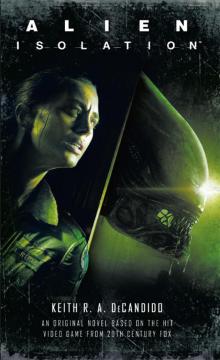 Alien
Alien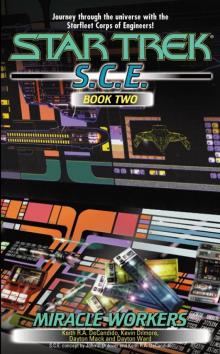 Miracle Workers
Miracle Workers Articles of the Federation
Articles of the Federation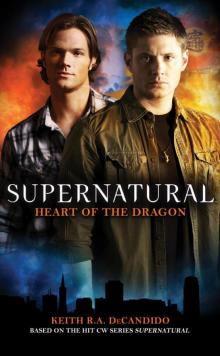 Supernatural Heart of the Dragon
Supernatural Heart of the Dragon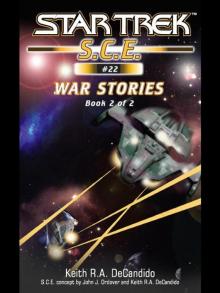 War Stories: Book Two
War Stories: Book Two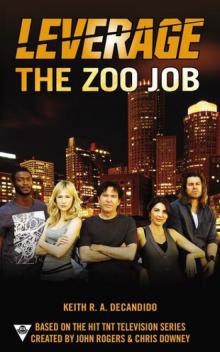 The Zoo Job
The Zoo Job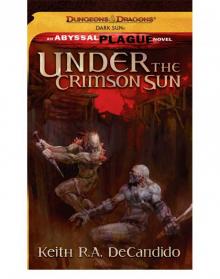 Under the Crimson Sun
Under the Crimson Sun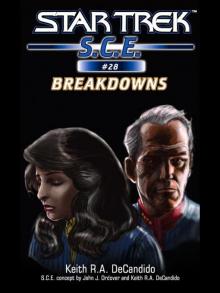 Breakdowns
Breakdowns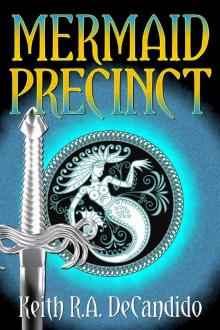 Mermaid Precinct (ARC)
Mermaid Precinct (ARC)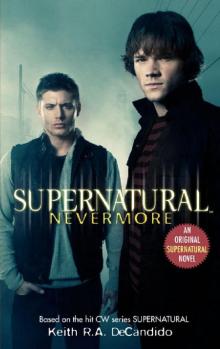 Supernatural 1 - Nevermore
Supernatural 1 - Nevermore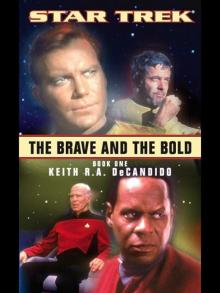 STAR TREK - The Brave and the Bold Book One
STAR TREK - The Brave and the Bold Book One Four Walls
Four Walls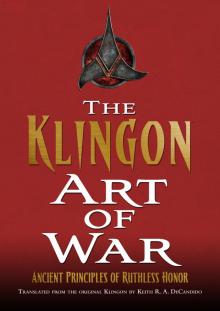 The Klingon Art of War
The Klingon Art of War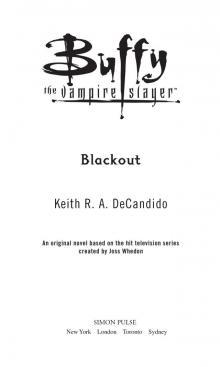 Blackout
Blackout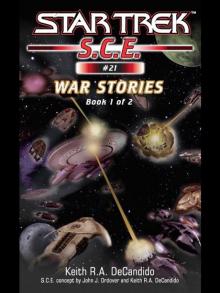 War Stories: Book One
War Stories: Book One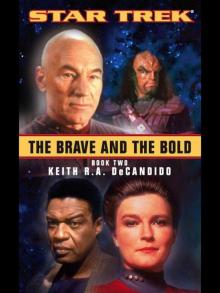 The Brave and the Bold Book Two
The Brave and the Bold Book Two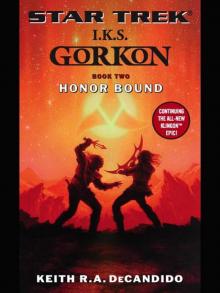 Honor Bound
Honor Bound Sleepy Hollow: Children of the Revolution
Sleepy Hollow: Children of the Revolution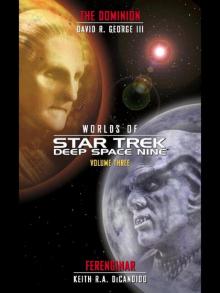 Worlds of Star Trek Deep Space Nine® Volume Three
Worlds of Star Trek Deep Space Nine® Volume Three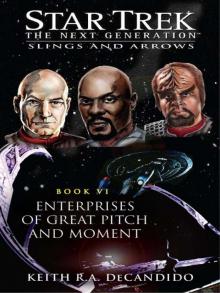 Star Trek: TNG: Enterprises of Great Pitch and Moment
Star Trek: TNG: Enterprises of Great Pitch and Moment Genesis
Genesis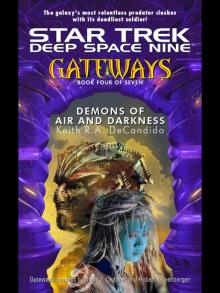 Demons of Air and Darkness
Demons of Air and Darkness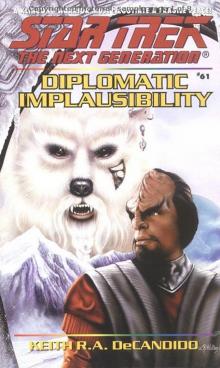 Star Trek - TNG - 61 - Diplomatic Implausibility
Star Trek - TNG - 61 - Diplomatic Implausibility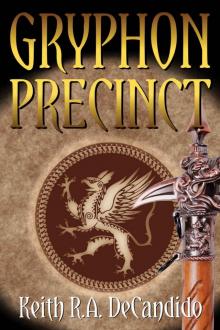 Gryphon Precinct (Dragon Precinct)
Gryphon Precinct (Dragon Precinct)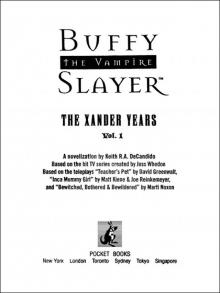 THE XANDER YEARS, Vol. 1
THE XANDER YEARS, Vol. 1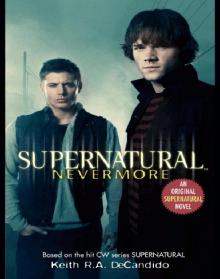 Nevermore
Nevermore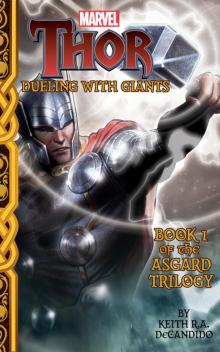 Thor
Thor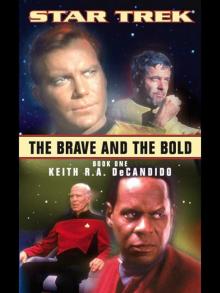 The Brave And The Bold Book One
The Brave And The Bold Book One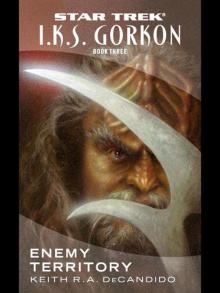 I.K.S. Gorkon Book Three
I.K.S. Gorkon Book Three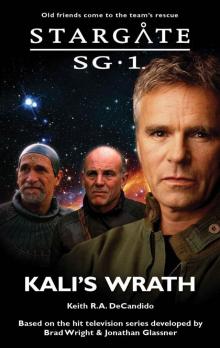 STARGATE SG-1: Kali's Wrath (SG1-28)
STARGATE SG-1: Kali's Wrath (SG1-28)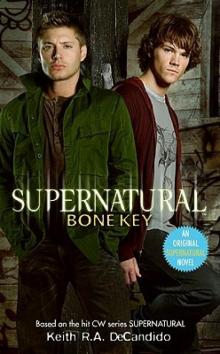 Bone Key
Bone Key Guilt in Innocece
Guilt in Innocece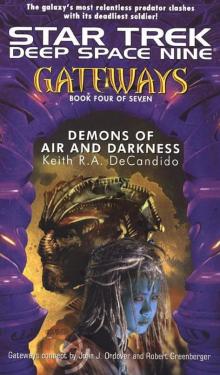 Star Trek - DS9 Relaunch 04 - Gateways - 4 of 7 - Demons Of Air And Darkness
Star Trek - DS9 Relaunch 04 - Gateways - 4 of 7 - Demons Of Air And Darkness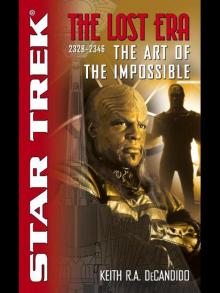 The Art of the Impossible
The Art of the Impossible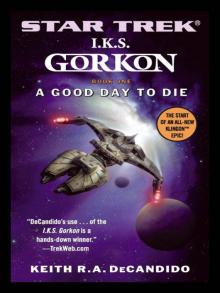 I.K.S. Gorkon Book One: A Good Day to Die
I.K.S. Gorkon Book One: A Good Day to Die Under the Crimson Sun (the abyssal plague)
Under the Crimson Sun (the abyssal plague)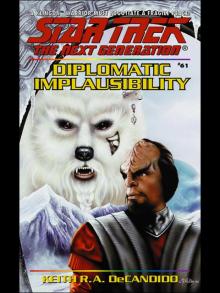 DIPLOMATIC IMPLAUSIBILITY
DIPLOMATIC IMPLAUSIBILITY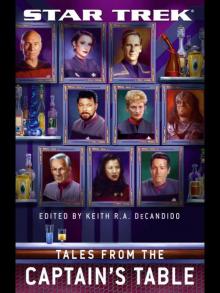 Tales from the Captain's Table
Tales from the Captain's Table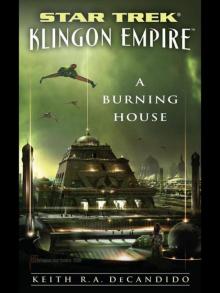 A Burning House
A Burning House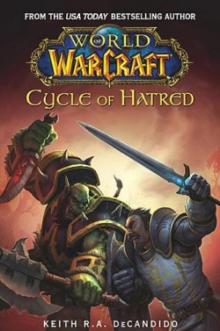 Cycle of Hatred (world of warcraft)
Cycle of Hatred (world of warcraft)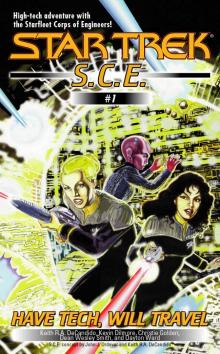 Have Tech, Will Travel
Have Tech, Will Travel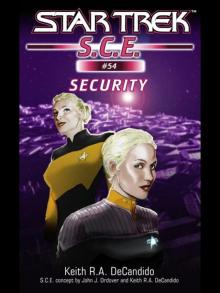 Security
Security